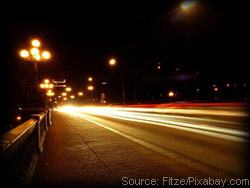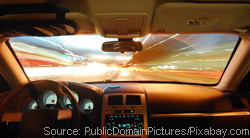Night driving can be difficult, annoying and not always safe. Limited visibility, nocturnal animals, poor depth perception and fatigue, make accidents more frequent when driving at night. Pick up some tips to make driving after dark a bit easier to handle.

Headlights
Making sure your headlights are in good working order may seem obvious, but you'd be surprised how small adjustments can impact the amount of light shining through.
- Aim your headlights correctly. Sometimes, the headlights are pointed too low, so it's worth the effort to adjust them. Use your owner's manual to make the changes. Just be sure that your headlights aren't going to blind oncoming traffic.
- Be sure to clean the exterior of your headlights every few months or as needed. The plastic lens covers pick up dirt and grime from the road causing them to yellow over time. Dirty lens covers will dim the light shining through. Auto parts retailers often sell polish kits to remove any haziness that may have accumulated over time.
TIP: Make sure both headlight bulbs work. If one needs to be replaced, it's often easier to replace them both at the same time. Be sure to follow manufacturer's instructions when installing new headlight bulbs.
Interior Lights
- Dim the lights on your instrument panels and the radio. If the lights are too bright it will interfere with your forward vision.
- Turn off the overhead lights. Interior lights in less-expensive cars disperse the light too much and shine into the driver's eyes. Luxury cars usually have a more focused light for reading maps and don't create as much glare.
Either way, avoid driving with the interior lights on.
Outside Light Sources
The brightness of an oncoming car's headlights can break your concentration when driving at night. You're already used to the darkness from the inside of the car and the dim glow from your instrument panel, then BAM! There's a glare from an 18-wheeler on the opposite side of the road.
Staring at bright road signs, high beams from other cars and even just headlights in front and behind you can be too distracting, so avoid it.
TIP: Adjust your rearview mirror to reflect the light from the cars behind you away from your eyes.
Mirrors and your Windshield
Visibility is easy to improve just by cleaning your windshield and your mirrors. You'll be able to see in front of you, to your sides and blind spots.
 Wipe your windshield with a newspaper. The newspaper will help reduce smudges which create glare from lights.
Wipe your windshield with a newspaper. The newspaper will help reduce smudges which create glare from lights.- Use a streak-free formula from your favorite glass cleaner to ensure no streaks.
- Brands like Rain-X offer special windshield cleaning formulas to repel water better which will definitely increase your visibility during bad weather.
Stay Alert
Staying alert is half the battle. On its own night driving can be dangerous, but add in fatigue and you may be in for a rude awakening.
- Avoid taking medications that make you drowsy.
- Eat foods that are high in protein rather than ones that are overloaded with carbohydrates that could put you in a carb coma after eating.
- Drink coffee or a caffeinated soda.
- Avoid alcohol. Alcohol impairs driving ability overall, so avoid it if you'll be driving at night.
- Bring someone with you, if possible. It's easier to stay alert if you've got someone to chat with, and of course in the event of an emergency you won't be alone.
Carry an Emergency kit
Keep an emergency kit in your trunk or backseat. They can be purchased with everything you'll need and can accommodate varied budgets. You can also create your own emergency kit for usually between $25 and $50.
It should include:
- Flashlights with extra batteries
- Jumper cables
- Flat tire repair kit - tire iron, car jack, tire sealant. Make sure your spare tire is in good repair.
- Quart of oil
- Bottled water - not just for drinking, if your car overheats, water can safely be used as an engine coolant.
- Blanket
- First aid kit